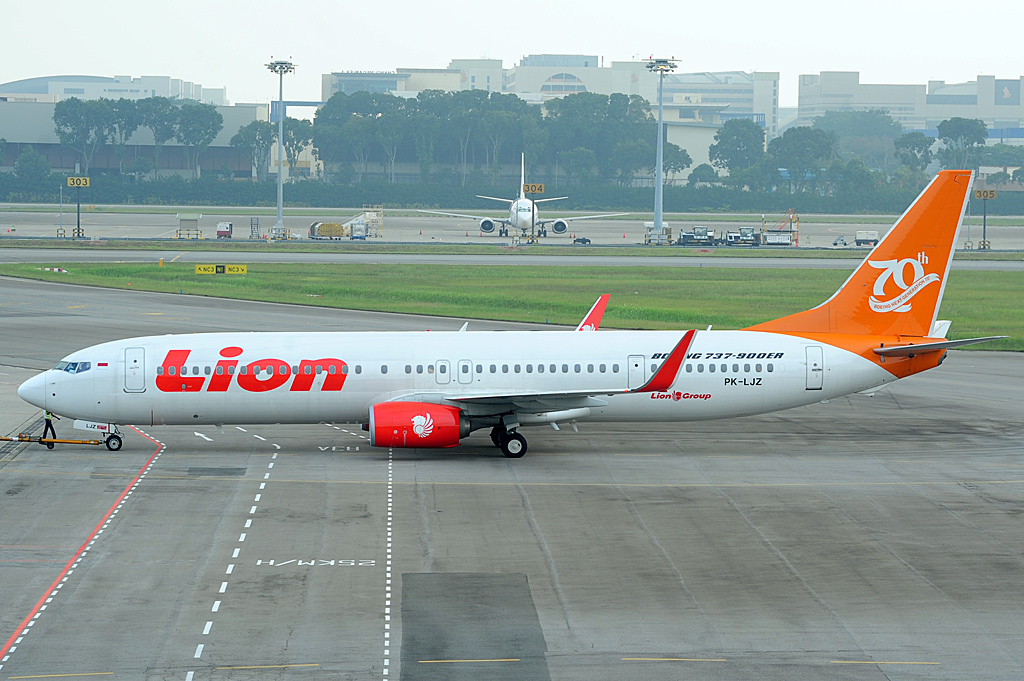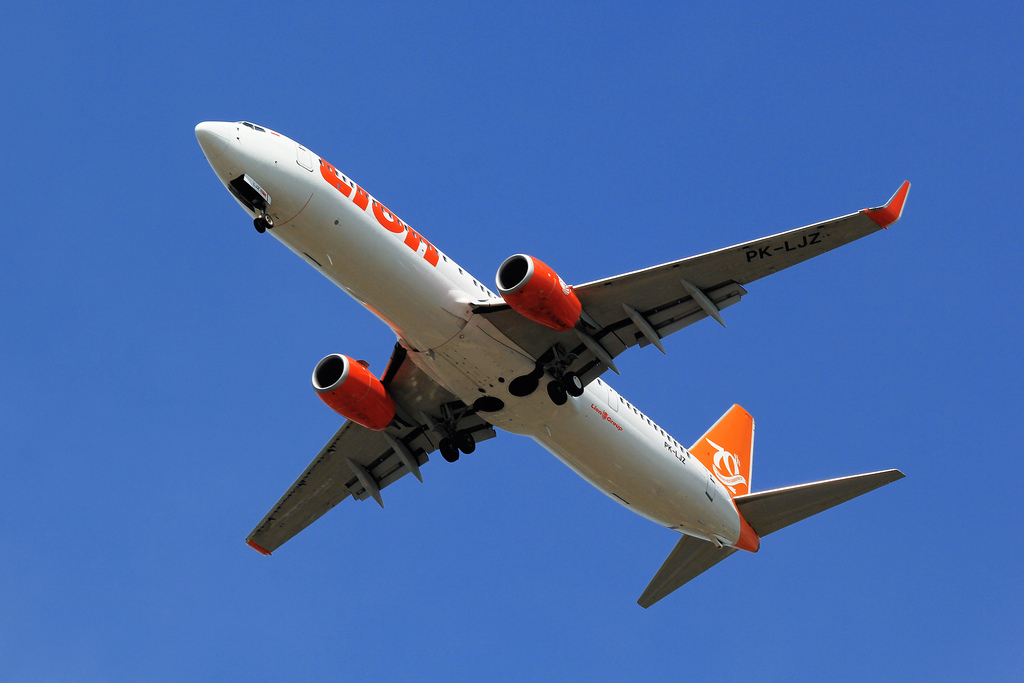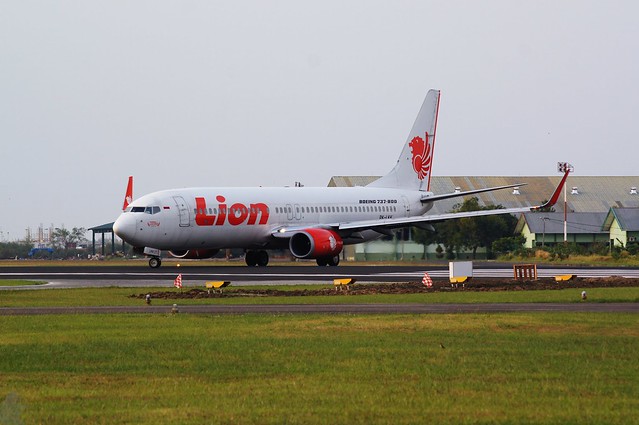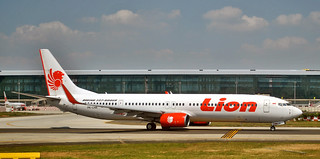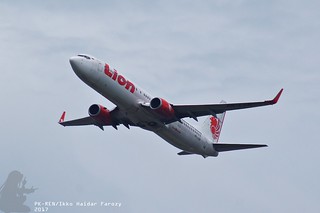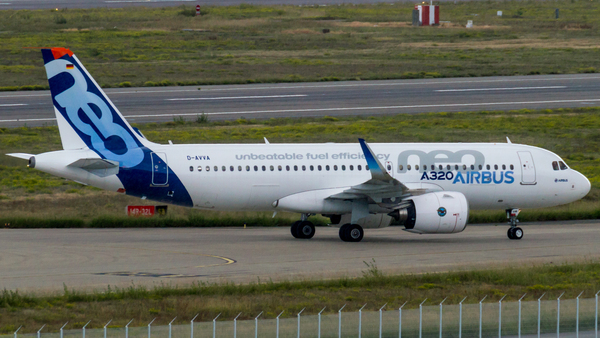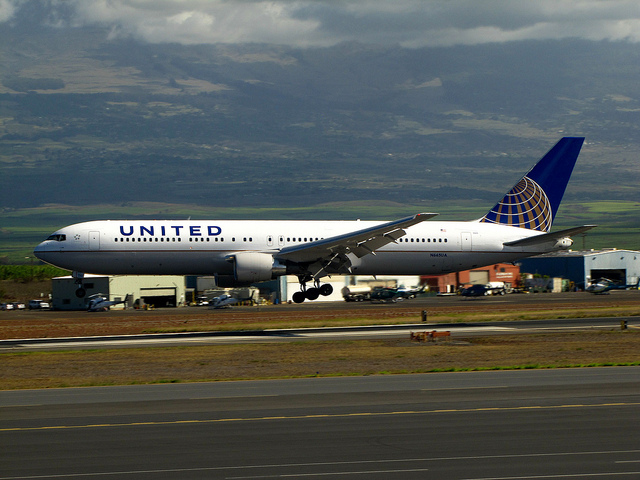Lion B739 and Wings AT72 at Medan on Aug 3rd 2017, collision on runway
Last Update: April 19, 2018 / 15:08:13 GMT/Zulu time
Incident Facts
Date of incident
Aug 3, 2017
Classification
Accident
Airline
Lion Air
Flight number
JT-197
Departure
Banda Aceh, Indonesia
Destination
Medan Kuala Namu, Indonesia
Aircraft Registration
PK-LJZ
Aircraft Type
Boeing 737-900
ICAO Type Designator
B739
Airport ICAO Code
WIMM
A Wings Air Avions de Transport Regional ATR-72-212A, registration PK-WFF performing flight IW-1252 from Medan Kuala Namu to Meulaboh (Indonesia) with 66 people on board, was lining up for departure from Kuala Namu's runway 23 from taxiway D at about 10:55L (03:55Z).
On Aug 3rd 2017 the airport as well as Lion Air had reported, that the collision had occurred on a taxiway well off the runway (rendering the occurrence a ground incident outside the coverage of The Aviation Herald). The airport further reported it had been a normal landing, the airport was not affected, there had been no closure with normal operation continuing.
However, on Aug 10th 2017 Indonesia's NTSC reported the Boeing 737-900 during the landing roll on runway 23 collided with the ATR-72 lining up runway 23 from taxiway D resulting in substantial damage. The NTSC rated the occurrence an accident and opened an investigation.
On Sep 5th 2017 the NTSC released their preliminary report reporting IW-1252 reported ready for departure from runway 23 intersection taxiway D.
The Lion Boeing received landing clearance on runway 23.
About one minute later IW-1252 was instructed to hold short of runway 23 at taxiway D, about another minute later the crew reported holding short of runway 23. Tower queried whether they were able to an immediate departure, repeated the query after receiving no reply and the crew confirmed they were able for an immediate departure.
Tower thus instructed IW-1252: "IW1252 behind traffic Lion on short final landed passing line up behind runway 23 from intersection D additional clearance after departure direct Meulaboh."
The crew read back: "departure direct to Meulaboh IW1252", tower acknowleged: "Namu Tower". IW-1252 continued to line up runway 23.
About 35 seconds after that last transmission JT-197 touched down and a few seconds later collided with the ATR. JT-197 reported there was another aircraft on the runway.
The NTSC reported there were no injuries, however, both aircraft sustained substantial damage.
The tower supervisor took over communication and instructed the next arrival to go around. JT-197 was instructed to vacate the runway via taxiway G. The controller subsequently cleared IW-1252 for takeoff, the crew declined "negative". The crew subsequently requested to return to the apron.
About 8 minutes after the collision JT-197 advised tower of the possibility of debris on the runway. The crew of another aircraft waiting for departure reported seeing debris on the runway. Tower issued a landing clearance to the aircraft that had gone around earlier. JT-197 advised again there was possibly debris on the runway, tower responded that maintenance had been informed. The aircraft on final landed and after landing reported foreign objects on the runway.
Only then the runway was closed for about 25 minutes until the debris had been cleared off the runway.
The NTSC reported the ATR was still on ground frequency when the landing clearance to JT-197 was issued. The NTSC reported further that the conditional taxi clearance to line up behind the landing traffic was issued without verifying the crew was able to see the landing traffic.
The NTSC released one immediate safety recommendation to AirNav Indonesia (ATC Service Provider) and another one to Wings Abadi. In addition, AirNav Indonesia and Wings Abadi already took safety actions.
On Apr 19th 2018 the NTSC released their final report concluding the probable cause of the accident was:
The communication misunderstanding of the conditional clearance to enter runway while the IW1252 pilots did not aware of JT197 had received landing clearance and the unobserved IW1252 aircraft movement made the IW1252 aircraft entered the runway.
The NTSC analysed:
In the previous experience, the Medan Tower controller did not recall any pilot misunderstanding a conditional clearance. Even though the readback was incomplete, the Medan Tower controller assumed that the pilot acknowledged the clearance properly and the required immediate action to correct the discrepancies of the pilot readback, was considered not necessary.
...
The IW1252 pilots assuming that they had clearance to enter the runway 23 for departure caused by combination of:
- requested confirmation from the Medan Tower controller for IW1252 to make an immediate departure,
- an incomplete understanding of clearance that was delivered faster than the requirement,
- absence of correction to the incomplete readback from the pilot of IW1252,
- information transmitted to other arriving traffic that the IW1252 would depart,
- the pilots of IW1252 not being aware of JT197 had received landing clearance.
...
At 04:00:46 UTC, at an altitude of 37 feet, the JT197 PM advised to the PF of the close position of IW1252 to the runway. The distance between these two aircraft was approximately 643 meters. At this time IW1252 had not crossed the runway side strip marking. The JT197 PF was aware that the clearance for the IW1252 was to enter the runway after the JT197 landed. The JT197 pilot assumed that the IW1252 would not enter the runway. Therefore, the JT197 PF decided to continue the landing approach and focused on handling the aircraft.
The NTSC analysed how the outcome of the occurrence would have been had JT-197 initiated a go around upon recognizing that the ATR was going to enter the runway and concluded the outcome would have been much more severe as the go around would not have prevented a collison. The NTSB wrote:
Refer to the condition above, assumed the JT197 pilot decided to go around at the first time when the PM suspected that the IW1252 aircraft was about to enter the runway at 04:00:46 UTC, the calculation was made as follows:
The FDR recorded the altitude was 37 feet, the ground speed was 160 knots, the distance to the IW1252 was about 643 meters and the N1 was indicated that the engines were not in idle position.
Taking into account an expected height loss shortly after a go-around is initiated, a go around executed as the aircraft was descending through 37 feet would most likely not have avoided the collision. Additionally, the time it took for the PM to advise the PF of the position of IW1252 may have resulted in further delays in initiating the go-around. Therefore, initiation of a go-around from 37 feet, may have resulted in more severe circumstances.
The NTSB analysed a collision was unavoidable: "The pilot decision to move away from the runway centerline avoided a centerline collision however, the wing collision was unavoidable. The wing collision was less severe compared than an aircraft collision on the runway centerline."
The NTSC analysed that a runway inspection was delayed and the runway remained open with several landing clearances issued following the discussion leaving debris on the runway. The NTSB wrote:
The collision occurred near the taxiway D intersection which was at about the 11 o’clock direction from the tower building (see figure 1 for the aerodrome layout). The Medan Tower controller was unable to clearly observe the collision, since the impact point was on the right side of the IW1252 and might have been obstructed by the IW1252 fuselage.
The collision resulted in damage to the left wing of JT197 aircraft, and the right wing and nose section of IW1252. Debris was scattered on the runway including the detached section of the right wing of IW1252 approximately 2.8 meters in length.
After the collision, the JT197 pilot informed Medan Tower controller of another aircraft on the runway when JT197 landed. The Medan Tower supervisor on duty noticed two aircraft on the runway and the Medan Tower controller panicked. Thereafter, the Medan Tower supervisor took over the communications on Medan Tower. The existing of two aircraft on the runway and the panic of the Medan Tower controller indicated that unusual condition had occurred.
The Medan Tower controller issued take off clearance to the IW1252 pilot which was rejected, and the pilot requested to return to apron to inspect the possibility of the aircraft damage. The pilots of JT197 and IW1252 did not report that a collision had occurred.
At 04:07:21 UTC, after the IW1252 vacated the runway, the Medan Tower supervisor issued takeoff clearance for other departure aircraft. This indicated that the Medan Tower supervisor was not aware of the collision, including the debris on the runway.
The condition of two aircraft on the runway and the departure aircraft requesting to return to apron for inspection for possible damage did not trigger the Medan Tower supervisor to seek further information of possibility of an aircraft collision.
At 04:08:55 UTC, the JT197 pilot advised the Medan Ground controller the possibility of aircraft debris on the runway that might become hazard to the other aircraft. The Medan Ground controller acknowledged this and relayed the information to the Medan Tower supervisor.
At 04:10:26 UTC, the other departure pilot after airborne advised to the Medan Tower supervisor that there were FOD on the runway.
At 04:10:44 UTC, the Medan Tower supervisor issued landing clearance to other arriving aircraft.
Two pilots had informed the Medan Tower supervisor of debris on the runway, who then informed the Airport Runway and Accessibility unit. While waiting for the runway to be inspected, other arriving aircraft landed.
At 0431 UTC, the Medan Tower controller closed the runway operation for runway inspection.
Metars:
WIMM 030500Z 06008KT 060V130 9999 SCT018 31/26 Q1009=
WIMM 030430Z 06007KT 040V100 9999 BKN018 31/26 Q1009=
WIMM 030400Z 11007KT 040V140 9999 BKN018 30/25 Q1010=
WIMM 030330Z 08005KT 030V120 9000 BKN018 30/26 Q1010=
WIMM 030300Z 07003KT 7000 BKN018 29/26 Q1010=
WIMM 030230Z 17004KT 120V250 6000 SCT018 29/26 Q1010=
WIMM 030200Z 17003KT 5000 HZ SCT018 28/26 Q1010=
WIMM 030130Z 23004KT 2500 HZ BKN018 27/25 Q1010=
WIMM 030100Z 20003KT 3000 BR BKN018 26/25 Q1010=
WIMM 030030Z 23004KT 2000 BR SCT018 25/25 Q1010=
WIMM 030000Z 22004KT 1800 BR SCT018 25/25 Q1009=
Incident Facts
Date of incident
Aug 3, 2017
Classification
Accident
Airline
Lion Air
Flight number
JT-197
Departure
Banda Aceh, Indonesia
Destination
Medan Kuala Namu, Indonesia
Aircraft Registration
PK-LJZ
Aircraft Type
Boeing 737-900
ICAO Type Designator
B739
Airport ICAO Code
WIMM
This article is published under license from Avherald.com. © of text by Avherald.com.
Article source
You can read 2 more free articles without a subscription.
Subscribe now and continue reading without any limits!
Read unlimited articles and receive our daily update briefing. Gain better insights into what is happening in commercial aviation safety.
Send tip
Support AeroInside by sending a small tip amount.
Related articles
Lion A333 at Madinah on Oct 29th 2024, passenger fell off stairs
A Lion Air Airbus A330-300, registration PK-LEH performing flight JT-74 from Surabaya (Indonesia) to Madinah (Saudi Arabia), had safely landed in…
Lion B738 at Jakarta on Oct 26th 2022, engine trouble
A Lion Air Boeing 737-800, registration PK-LKK performing flight JT-330 from Jakarta to Palembang (Indonesia) with 169 passengers and 6 crew, was…
Lion B738 at Surabaya on May 18th 2022, bird strike
A Lion Air Boeing 737-900, registration PK-LHR performing flight JT-800 from Surabaya to Makassar (Indonesia) with 222 passengers and 7 crew, was…
Lion B739 at Padang on Dec 13th 2021, cabin did not properly pressurize
A Lionair Boeing 737-900, registration PK-LQR performing flight JT-145 from Padang to Batam (Indonesia) with 196 passengers and 7 crew, was climbing…
Lion B739 at Bandar Lampung on Dec 20th 2020, runway excursion during backtrack
A Lionair Boeing 737-900, registration PK-LGP performing flight JT-173 from Batam to Bandar Lampung (Indonesia) with 125 passengers and 7 crew, had…
Newest articles
India A20N at Delhi on Nov 27th 2025, cargo smoke indication
An Air India Airbus A320-200N, registration VT-EXO performing flight AI-2939 from Delhi to Ahmedabad (India) with 170 people on board, was climbing…
United B763 near Boston on Nov 27th 2025, airspeed indication problem
A United Boeing 767-300, registration N665UA performing flight UA-934 from Newark,NJ (USA) to London Heathrow,EN (UK), was enroute at FL300 near…
Subscribe today
Are you researching aviation incidents? Get access to AeroInside Insights, unlimited read access and receive the daily newsletter.
Pick your plan and subscribePartner

ELITE Simulation Solutions is a leading global provider of Flight Simulation Training Devices, IFR training software as well as flight controls and related services. Find out more.
SafetyScan Pro provides streamlined access to thousands of aviation accident reports. Tailored for your safety management efforts. Book your demo today
AeroInside Blog
Popular aircraft
Airbus A320Boeing 737-800
Boeing 737-800 MAX
Popular airlines
American AirlinesUnited
Delta
Air Canada
Lufthansa
British Airways
